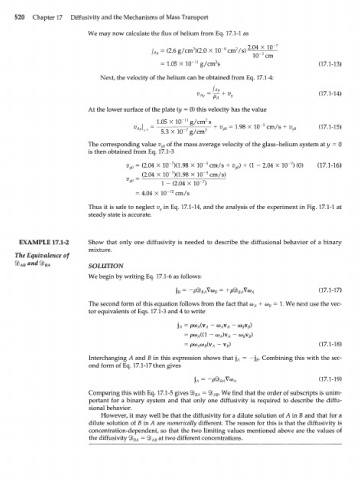Page 540 - Bird R.B. Transport phenomena
P. 540
520 Chapter 17 Diffusivity and the Mechanisms of Mass Transport
We may now calculate the flux of helium from Eq. 17.1-1 as
2.04 X 1Q-
j = (2.6 g/cm )(2.0 X 1(T cm /s)
2
3
8
Ay 3
10~ cm
2
= 1.05 X 10" 11 g/cm s (17.1-13)
Next, the velocity of the helium can be obtained from Eq. 17.1-4:
_ ]Лу
(17.1-14)
At the lower surface of the plate (y = 0) this velocity has the value
1.05 X 10" g/cm s
n
2
= 1-98 x (17.1-15)
7
5.3 X 10~ g/cm 3
The corresponding value v of the mass average velocity of the glass-helium system at у = 0
yQ
is then obtained from Eq. 17.1-3
7
5
7
v = (2.04 X 10" )(1.98 X 10~ cm/s + v ) + (1 - 2.04 X 10" ) (0) (17.1-16)
y0 y0
7
5
(2.04 X 1Q- )(1.98 X 10~ cm/s)
=
Vy0 1 - (2.04 X 10~ )
7
12
= 4.04X 10~ cm/s
Thus it is safe to neglect v in Eq. 17.1-14, and the analysis of the experiment in Fig. 17.1-1 at
y
steady state is accurate.
EXAMPLE 17.1-2 Show that only one diffusivity is needed to describe the diffusional behavior of a binary
mixture.
The Equivalence of
SOLUTION
We begin by writing Eq. 17.1-6 as follows:
-
] = <3) V(D = + <$ Va) (17.1-17)
B P BA B P BA A
The second form of this equation follows from the fact that io + o) = 1. We next use the vec-
A B
tor equivalents of Eqs. 17.1-3 and 4 to write
) = pa> {v - o) v - o) v )
A A A A A B B
= pa) ((l - <x) )v ~ o) v )
A A A B B
- v ) (17.1-18)
e
Interchanging A and В in this expression shows that \ = —] . Combining this with the sec-
A B
ond form of Eq. 17.1-17 then gives
) A (17.1-19)
Comparing this with Eq. 17.1-5 gives %b BA = ЯЬ . We find that the order of subscripts is unim-
АВ
portant for a binary system and that only one diffusivity is required to describe the diffu-
sional behavior.
However, it may well be that the diffusivity for a dilute solution of Л in В and that for a
dilute solution of В in A are numerically different. The reason for this is that the diffusivity is
concentration-dependent, so that the two limiting values mentioned above are the values of
the diffusivity %b = 4b at two different concentrations.
BA AB

